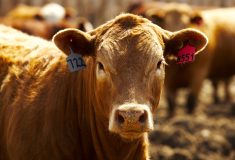For every food that is offered to the consumer, there comes a time when the product is rejected because of composition, perception or price.
This “price point” is a risk that takes into consideration brand recognition, production and distribution cost, and considerable marketing demographics. As domestic beef nears the wall on price we may wish to revisit our relationship with consumers.
Wholesalers and retailers themselves have become directly involved in product development to keep people interested and buying. They do this because they are closer to the consumer and have the power to set production protocols. A block of cheese is just a block of cheese but an artisan cheese soaked in honey and wrapped in hay is a pretty exciting deal. And, it clearly advances price point on what basically started as the same milk product. Another way to advance price is through product differentiation by protocol, such as “antibiotic free.” Although you may not see the price of the burger change, the price point is advanced by downsizing on the offering or on the sides. Every time there is an added perceived or real value, the consumer engages. In all cases the commodity industry, such as beef, is a respondent to the product offering rather than being active in the dialogue for the creation of it.
Read Also

Where is the top of the fed cattle market?
In late April, Alberta packers were buying fed cattle on a dressed basis at $486/cwt delivered, up about $30/cwt from…
- More ‘Straight from the hip’ on the Canadian Cattlemen: Lean in our approach
So what is the point? Cattle prices are good. Export doors will likely continue to open. The U.S. buys most of our commodity so Big Brother takes care of us. Why challenge the system now? To say that the current cattle prices are a result of innovation or value transfer is pure nonsense. It is a demand-pull that will adjust when beef busts the point of price. Value from end product, co-product and byproduct has not been transferred down the line. It may be easy at the moment to be lulled by the underwriting of a weak Canadian dollar and continue to focus on increasing commodity exports, but we must ask ourselves — is that a long-term solution to the disconnect with end product and with consumers?
Dan Barber author of The Third Plate, wrote: “Food is a process, a web of relationships, not an individual ingredient or commodity.” I like this quote because it de-commoditizes beef and allows us to go into the disbursement of the thought silo that beef is simply a commodity and that what we do has no relation to food. If we are to erase the tension between eating and farming we first must recognize that our relationship to the consumer is the main focus in full engagement towards softening price-point resistance and continued consumption of beef.
Consumers say they have little choice. Although they love farmers, they hate or misunderstand the process that clearly allows them to have massive product offerings on the shelf. The information they get is mixed, emotional, defensive or outrageously incorrect. In response to not knowing, they buy in areas that they do understand — local, antibiotic free, grass fed, gluten free and so on. It is not their responsibility to sift out fact from fiction; it is ours to engage with them at every level.
The confusion exists all through the chain. In July of this year, The Guardian reported on a study conducted by professor Gidon Eshel, at Bard College in New York state: “The heavy impact on the environment of meat production was known but the research shows a new scale and scope of damage, particularly for beef. The popular red meat requires 28 times more land to produce than pork or chicken, 11 times more water and results in five times more climate-warming emissions. When compared to staples like potatoes, wheat, and rice, the impact of beef per calorie is even more extreme, requiring 160 times more land and producing 11 times more greenhouse gases.”
At a time of heightened consciousness and in the age of self-formation, we cannot begin to appreciate the impact on consumption and the price trigger to a consumer armed with this type of information. I have hung around the meat counter in an ordinary grocery store and listened to men and women grill the butcher on the source of the cut, how it was raised, what did it eat and so on. They want to know and they are waiting for us to tell them.
Aristotle claimed the whole was greater than the sum of its parts. In modern day language, we liken this to synergy or a collective energy that can achieve much more through co-operation than working as individuals in a group. Co-operative exercises keep all players fully engaged in a common outcome. One interest does not override another, nor does corporate history trump youth, culture, gender, age, location or innovation.
I see this as a beginning. As an industry we may not have control over prices set by retail but we have a strong say in who we are, what we do and why we care. An engaging relationship with secondary processors, retailers and food service would give us an opportunity to be part of the creation of new product lines. The way the beef industry responds now, scrambling to meet change, will never transfer value. If there was one point to agree on collectively and co-operatively with regard to our domestic market then perhaps we could apply some Greek logic and get to the point of full consumer appreciation and mutual engagement with product development. If not we may see the breaking point on price, perception or product composition.
Brenda Schoepp is a motivating speaker and mentor who works with young entrepreneurs across Canada and around the world. She can be contacted through her website www.brendaschoepp.com. All rights reserved. Brenda Schoepp 2014
















